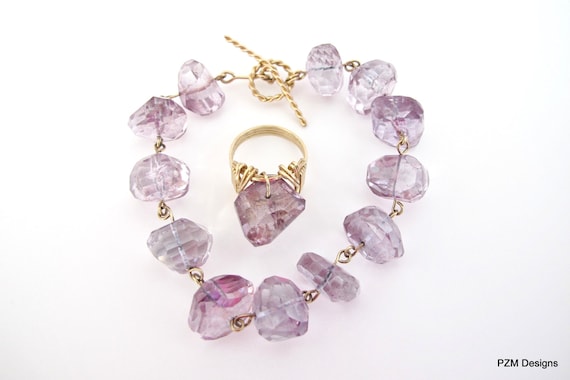The Quartz Family Posted on 1 Sep 07:55
Quartz is one of the most plentiful minerals on the planet. Humans have been using quartz in jewelry for thousands of years. Read on to learn more about the colors of Quartz.
Members of the quartz family may look different but they are essentially made up of the same elements, silicon and oxygen. They crystallize in the trigonal crystal system and they differ mostly in the size of their crystals.
All quartz can be divided in to three broad categories:
Large single or twinned crystals - Quartz varieties with large crystals include
Amethyst - this gemstone has been the most prized for centuries. Prized for its purple color, the Greeks thought it had magical and medicinal properties. It once was a considered an equal to ruby, emerald and sapphire.

Smokey Quartz - transparent brown, the color ranges from light yellowish brown or orange-brown to a dark brown that is almost black. The gem gets its color from natural radiation. Smokey quartz has been confused with topaz because of their color, but topaz is a totally different mineral, and much more costly.
Citrine - The beautiful color of citrine comes from a traces of iron. Citrine can come in many shades from yellow to reddish orange, to brownish orange. Dealers look for citrine without color banding but I love to see this in the large stones as it makes them more interesting to me.
Natural citrine is rare so most of it on the market is heat treated, which causes some amethysts to change color. The more saturated the original amethyst is, the more saturated the resulting citrine will be.
Ametrine - this is a transparent two colored variety of amethyst. It contains both the amethyst and citrine colors in the same stone. Bolivia is the only source of natural ametrine.
Rock crystal - Crystal Quartz - This is transparent, colorless quartz and was first discovered by rock climbers in ancient Greece where they first believed that it was melted ice.
It often has eye visible inclusions in unusual shapes and textures which can add to the beauty of the gem.
Sometimes there are needle-like inclusions, called rutiles, which are each classified according to their shapes. Some rock crystal can display a phantom effect which is an outline of an earlier growth phase.
Rose Quartz - Rose quartz gets its name from its delicate pink color, ranging from very light pink, almost white, to medium dark pink. Rose quartz can be transparent, semi transparent, translucent to opaque.
Rose quartz can be faceted and cut in to cabochons and beads. Usually, the larger the stone the more intense the color. Check out this rose quartz cuff.
This is an example of transparent Rose de France Amethyst. It is a light pinkish lilac color. It looks beautiful set in gold. Check out the ring here,
Microcrystalline, aggregates of small but not microscopic crystals
Some varieties of microcrystalline quartz are
Aventurine - also know as quartzite are tightly packed crystals. The gem quality quartzite is know as aventurine. It can be translucent to opaque and it glitters due to tiny inclusions of mica crystals or other minerals.
Tiger's Eye - this is a chatoyant (cat's eye) variety of color banded quartz which look like a billowing sheen of satin floating across the gem's surface. Tiger's eye can be a variegated grayish blue or brown with gold. Usually heat treated to enhance the reddish brown color.
Cryptocrystalline, aggregates of tiny microscopic crystals
Quartz with microscopic crystals, or Chaledony, (cryptocristalline is from the Greek word "hidden")
Chalcedony includes gems like
Carnelian - is a warm hued chalcedony which has been appreciated since ancient times. It is semitransparent to translucent and the colors can range from yellowish orange through orangy red to brownish orange. It can also display color banding. check out this bracelet
Chrysocolla-in-chalcedony - This is perhaps the most valuable of the chalcedonies. and gets its name from the mineral chrysocolla which are bright blue inclusions in the gem. It can range from translucent to semitranslucent with an intense light blue or blue green color.
Jasper - This mineral is opaque and comes in a variety of colors, typically brownish red, yellows, and blacks. It can be variegated or display straight color bands. It is a hard gem which can take a high polish, adding to its beauty.
Agates - This banded chalcedony can vary in color and transparency adding to their popularity and beauty. Agates are frequently dyed producing striking effects. Geodes often form in the cavities of agate deposits.
This is an example of a geode, notice the color banding around the outside of the geode.

Black Onyx - which is a dyed black chalcedony and used to be worn as mourning jewelry.
Check out some of our fabulous quartz pieces
Pink Agate and Pearl Necklace where you will see the color banding
Black Onyx Tennis Bracelet - this is black chalcedony
Fire Agate Tennis Bracelet - fire agate is pair with aventurine quartz
Carnelian Wire Wrapped Cuff - 2 large carnelian stones set in copper
Citrine Multi Strand Bracelet - shows off varying shade of citrine
Please visit my shop here where you will find many more exotic gemstone pieces.






